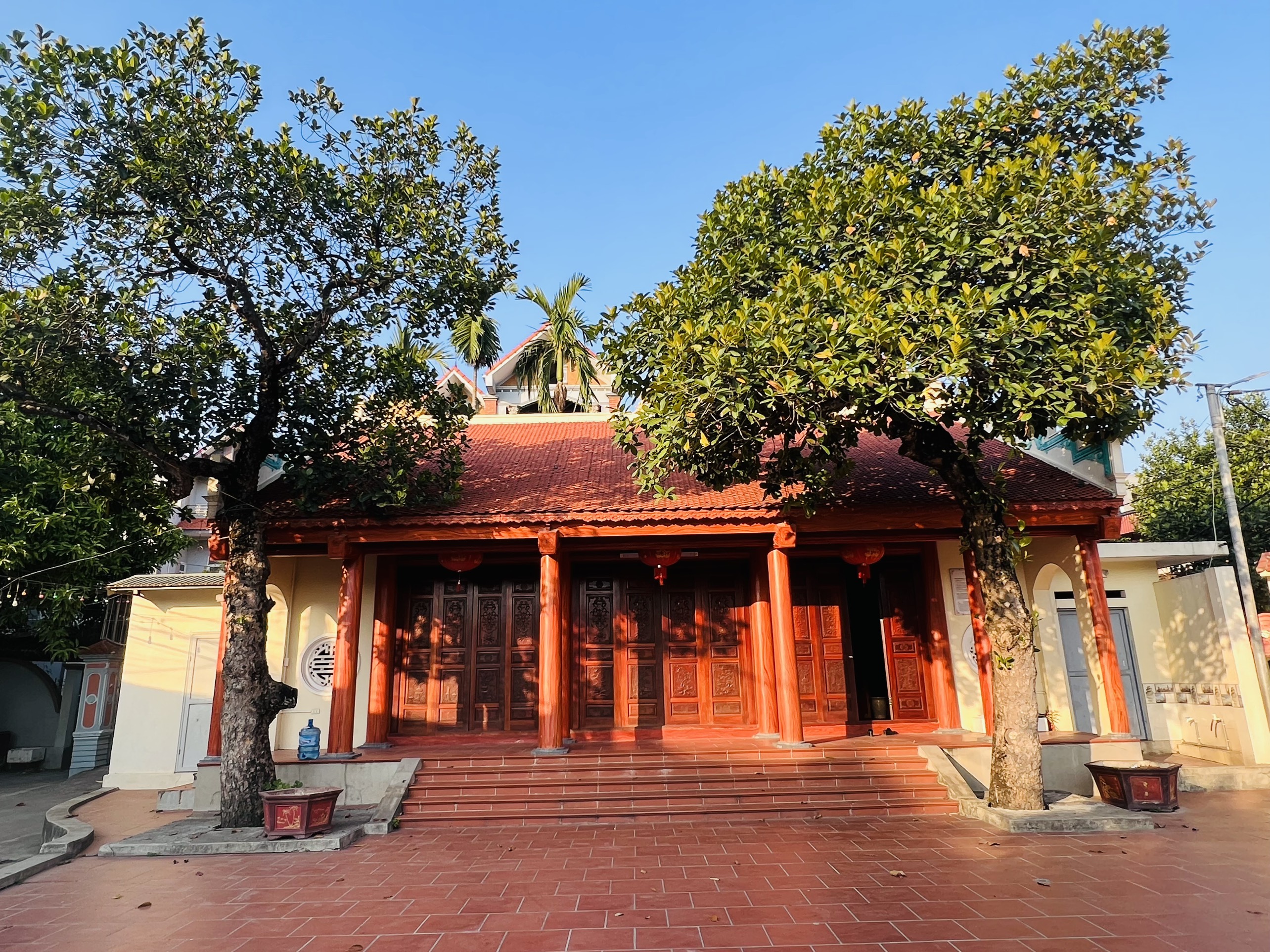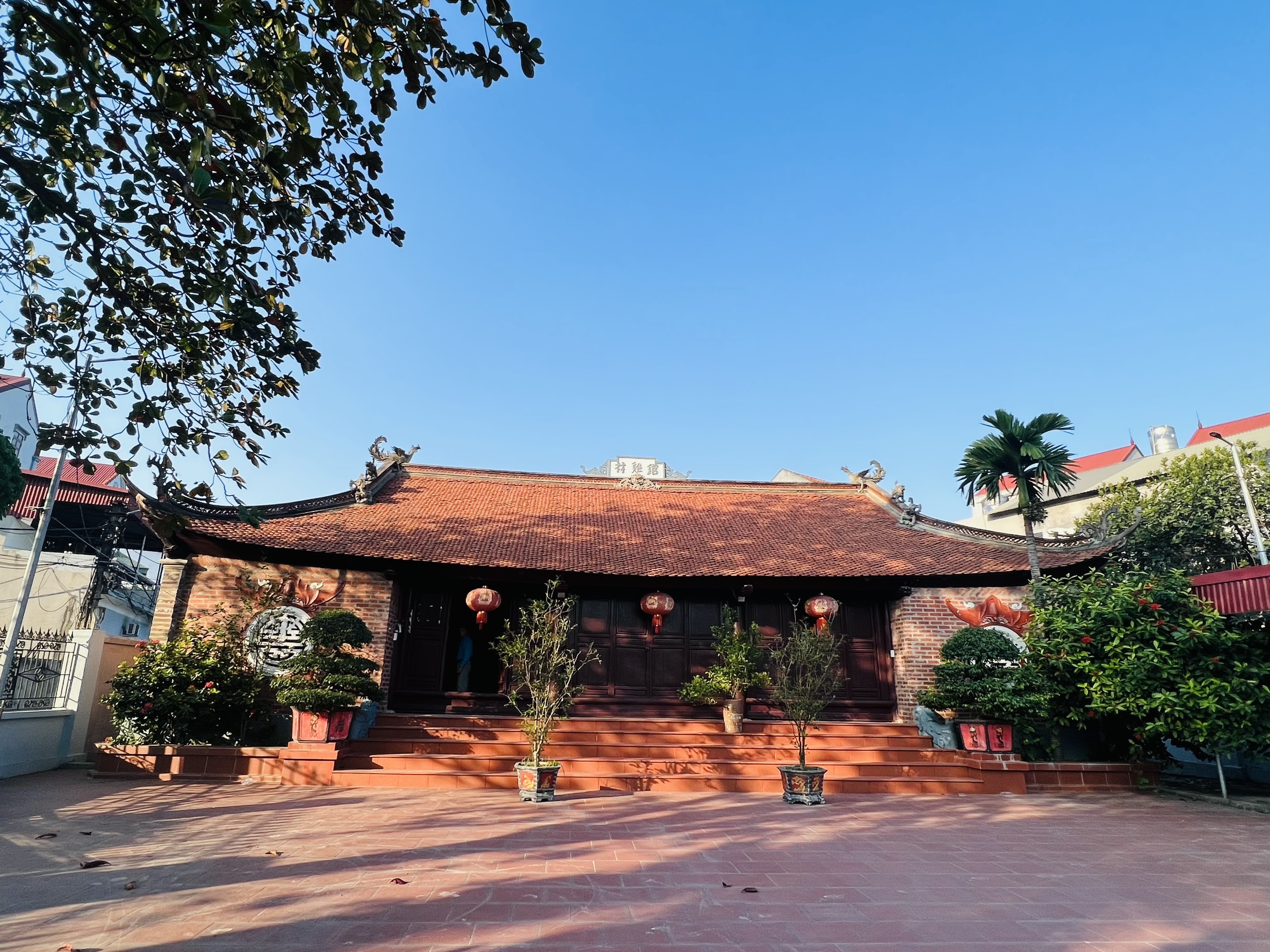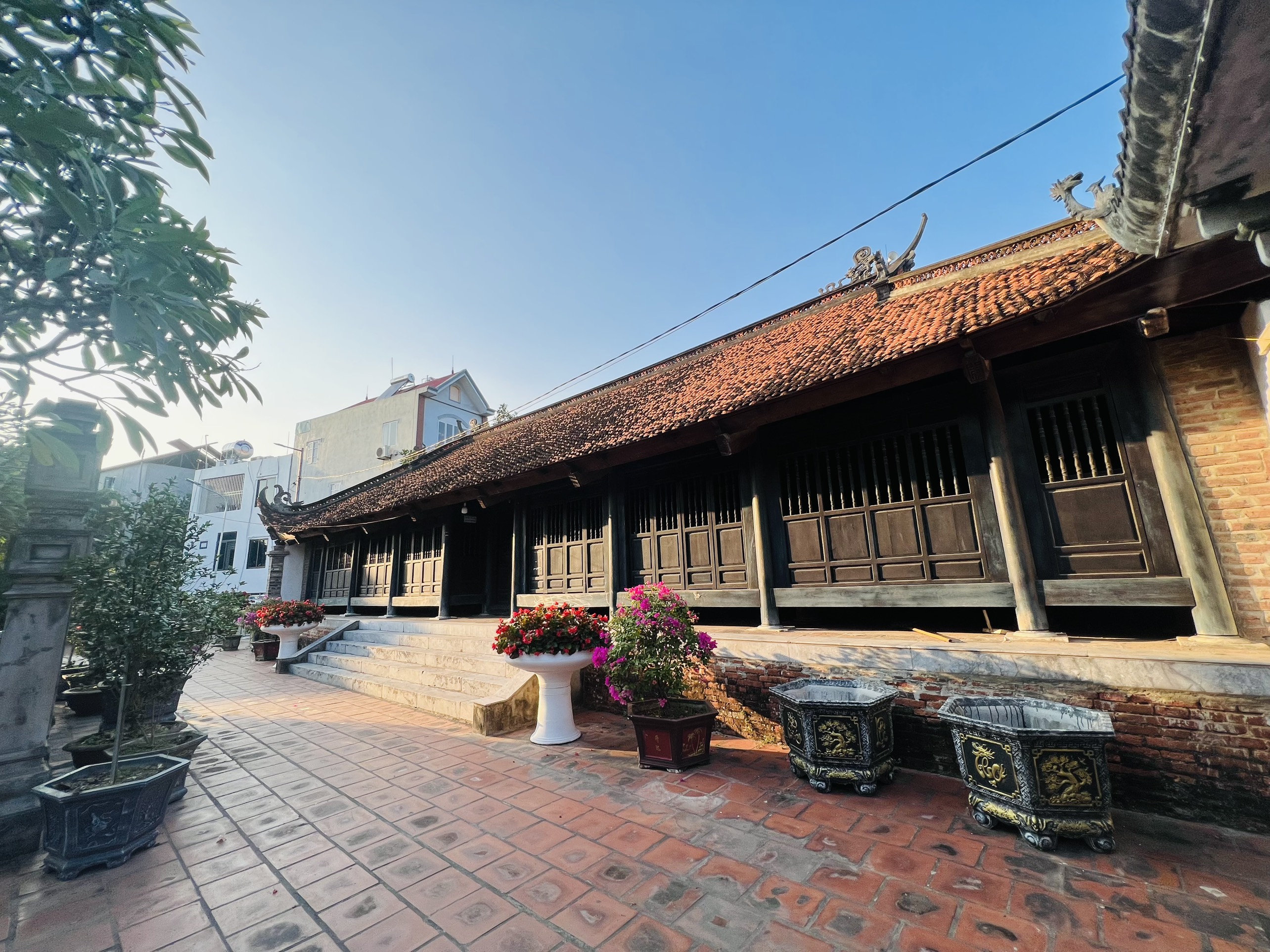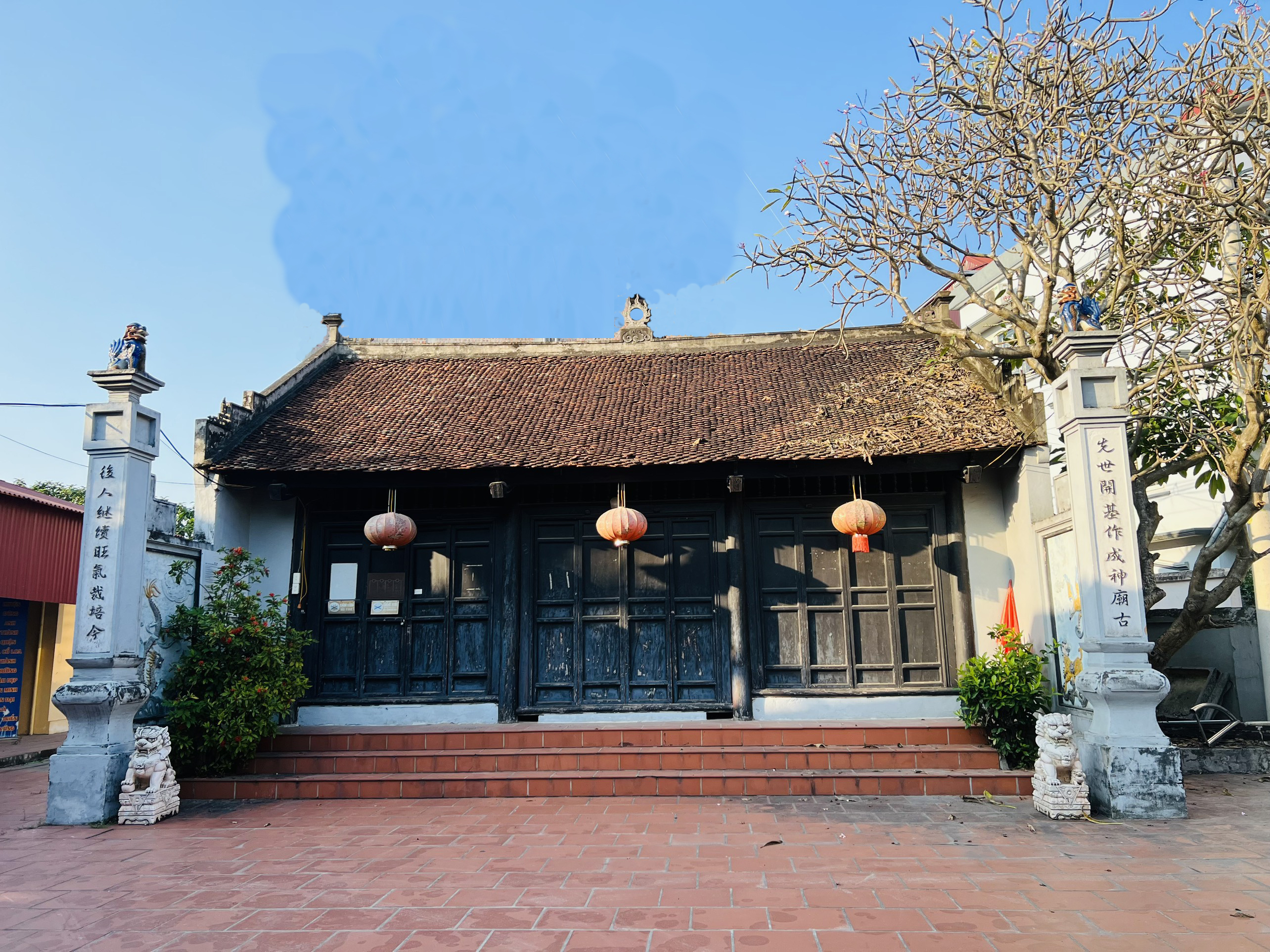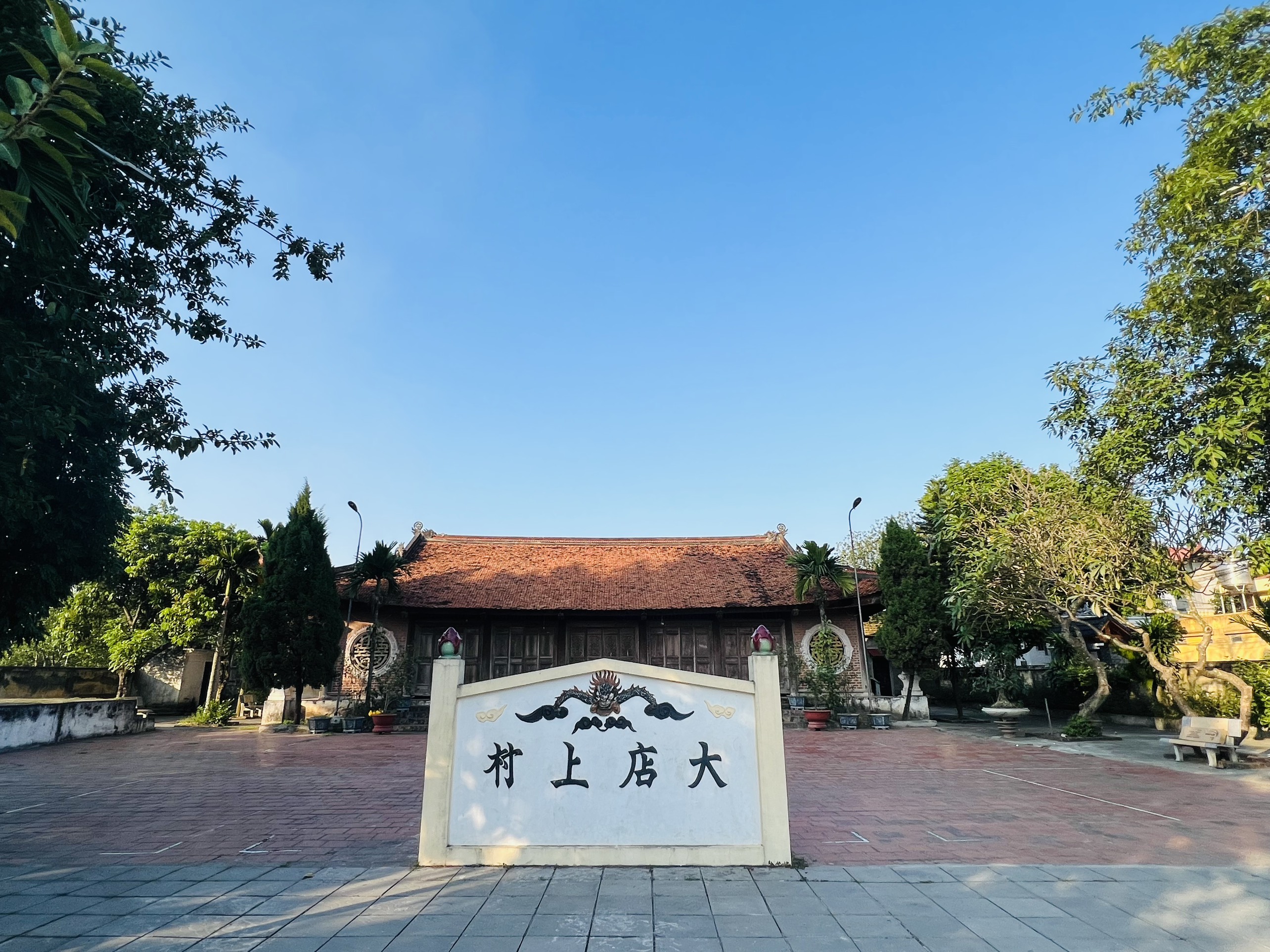The pagoda has Chinese name is "Quang Linh Tự", meaning radiant and sacred. However, like many other places, pagodas are often called by place names, so they are often called Mạch Tràng pagoda.
Mạch Tràng was originally a village (at one time a commune - "one hamlet one commune") with a long history, located in the south outside Cổ Loa citadel, on a high land, next to the Hoàng River. According to legend: From the Âu Lạc period, An Dương Vương brought barley to teach people to plant and put Âu Lạc's food warehouse here. Later, under Ngô Quyền's reign, he opened a national school, so it was named Mạch Tràng.
Mạch Tràng pagoda
Mạch Tràng Pagoda has a total area of nearly 5,000 square meters. The three-door temple gate, adjacent to the village road, has a path through the garden and pond leading to the Forecourt and the Upper Palace, where there are two “Giải Vũ” buildings as two corridors leading to the houses that worship Ancestor and Holy Mothers in the back.
The three-door temple gate is located on the "main road” of the temple, is a wooden structure with three compartments, 2-storey and 8-roofed, and a throne. The whole work has four wooden trusses with the middle space wider than the two side ones, designed in the style of "Thượng chồng rường - xà, trung chồng rường - giả thủ" sitting on the beams; “vì hạ” has “bẩy hiên” both front and back. This architecture has two functions: Gate and steeple. On the roof of the middle truss is inscribed with the fifth Khải Định date (1920), this is the date of a temple renovation.
Steeple of Mạch Tràng pagoda
The Forecourt has 5 compartments and 2 hips, has a wooden frame with the roof is covered with Vietnamese Terracotta Roof Tiles. The name of the pagoda "Quang Linh Tu" in Chinese characters is emblazoned on the center of the roof. The wooden trusses are made according to the formula "Thượng chồng rường kê đấu, trung chồng xà kê trụ, tiền kẻ, hậu bẩy". On the main wooden structures of forecourt, there are gently carved and decorated with cloud, chrysanthemum or lotus petals. However, it is worth noting that in the two "Bán mê" boards in the middle truss, there are embossments like a relief depicting the "Four Spirits Gathering". Dragon combined with the Four Precious in the body below. They are quite beautiful architecture decorations.
Burn Incense space - The Upper Palace connects the roof to the middle of the Forecourt, consisting of four compartments and 2 hips. The wooden trusses here have the form: "Thượng chồng rường, con nhị, hạ kẻ truyền", but the beams pillow on the wall on both sides, so there are actually only two rows of columns.
The simple plastered wall pedestals are placed in the central compartments at four levels and close to the back walls. On the pavilions of the Burn Incense space - Upper Palace are decorated with wooden doors and parallel sentences with the content praising the Buddha.
Behind the Upper Palace, a small yard away is the Patriarch and Holy Mothers-worshipping House. This is a building with five compartments made in the shape of Chinese word "丁" but only two compartments behind. Two corridors are connected through this architecture to form a common path in front. The sets are all in the form of "Chồng cốn, kẻ chuyền, tiền kẻ, hậu bẩy" and built in a "bít đốc, chừa hiên" style. In front of both sides of the corridor, there are two tomb towers. In addition, there is another tower located after Tam Quan (three-arched-entrances gate).
In general, the architecture of Mạch Tràng pagoda dates back to the late 18th and early 19th centuries. Some buildings have been restored in the 20th century and recently, there was a major renovation in two years 2000-2001, so the structures are very strong because they have been replaced by strong materials such as ironwood , bricks or tiles have been restored, but the traditional architectural style is still preserved - especially the decorations and wood carvings in the temple.
The first is the wooden door in the Upper Palace area with the style of carving, it is called the "Thiều Châu" wooden door. On the "Thiều Châu""Shao Chau" paintings, the artists have harmoniously combined the realistic and stylized ways to represent the images of "Four Supernatural Creatures" and "Four seasons" - mainly "pine, chrysanthemum, bamboo, apricot". There are delicate carvings showing mascots such as dragons, tigers or flowers interwoven on the background of “Four seasons” trees.
The wooden doors are carefully painted, brightly colored, with the artistic style of the Nguyen Dynasty in the 19th century. These are unique relics that add to the beauty and value of the architecture in Forecourt and Upper Palace.
There are seven horizontal paintings and seven pairs of couplets in the temple with the content praising the Buddha with the writing style of seal characters and decorated with lemon flower strings around the border.
Some of the carvings on the shrine and medical school include many meticulously carved decorative motifs: "Four Supernatural Creatures", "Four seasons", "Two dragons adoring the moon", Small Lion, Phoenix, “Turtle and lotus", “Tiger Face”.
Most of the carvings in this temple are in the artistic style of the temple's construction period.
There are 38 statues made of earth-wood materials, mainly worshiped in the Upper Palace.
Like in many other pagodas, the “Tam The” statues are placed on the highest pedestal next to the wall with the same size and shape, sitting on a lotus pedestal. The statue is made in the traditional style: The top of the head is raised, the hair is in rows of snail like curls, the eyebrows are arched, the eyes are half-closed looking down, the mouth is closed, the neck is three rows high, the ears are big and long; wearing a monk’s robe, hands resting on the thighs.
The second layer of statues is “three Amitabha buddhist statues", with the monk’s robe depicted very vividly, along with "Great Wisdom Bodhisattva" and "Avalokitesvara Bodhisattva" on both sides. Amitabha Buddha represents supernatural power to save sentient beings as a support for human beings.
Next is the statue of Shakyamuni Buddha and the statues of “Ananda" and “Kassapa" - the two assistants of the Buddha, in which " A Nan Đà " is considered the second Patriarch of the "Zen Buddhism".
The fourth layer, close to the incense burning area, on the same pedestal, has the statues of " Maitreya" and " Dìzàng in the middle outside is the “nine dragons” court. In the corridors on both sides, there are pedestals with four statues of "Ten Kings of Hell" and "Bodhisattva", the statue of the Master.
Finally, in the innermost part of the Upper Palace, there are two statues of Guanyin The Cuu Long Court here describes a cave with nine dragons spraying water; In the middle there is a statue of "Newborn Shakyamuni", around the cave there are small statues showing the stages of Buddha and Bodhisattvas. The Cuu Long Palace is elaborately carved, painted with gilded paint, like a vivid picture depicting Shakyamuni Buddha when he was born with a famous image:
The “nine dragons” Court here describes a cave with nine dragons spraying water; In the middle there is a statue of "Newborn Shakyamuni", around the cave there are small statues showing the stages of Buddha and Bodhisattvas. The “nine dragons” Court is elaborately carved, illuminated, like a vivid picture depicting Shakyamuni Buddha when he was born with a famous image: “Thiên thượng, Địa hạ, duy Ngã độc tôn”.
Most of the statues are carefully illuminated. Although the number is not much, it shows the skillful art of making, dating from the 18th and 19th centuries.
A remarkable thing is that in the temple, there is a statue of Hau - a man and a woman, with a realistic style, a close and lively appearance. The expression of hair, shirt, and hat reflects the noble family of "Hau". Maybe this is true with the legend that: It was a princess of the Trinh lord and her husband had merit in building the temple, so it is worshiped here. These are two earthen statues placed on a wooden lotus pedestal and illuminated.
At the Patriarch and Holy Mothers-worshipping House, the harem has an altar to worship the four Holy Mothers: Thượng Thiên mother, Thượng Ngàn mother, Thoải mother and Địa mother; Four Emperors and Saints. Outside, there is an altar "Four palaces of the community" and two statues of him standing in adoration. The monks of the pagoda are worshiped in two compartments of Forecourt: the right side is for the ancestor, the left is for the benefactor. Every year, the death anniversary of the ancestors is solemnly held on the 28th day of the second lunar month.
Holy Mother worship, as we often see in temples, is a reflection of a folk belief concept, but it was strongly developed about three centuries ago, due to certain historical conditions.
The worshiping statues in Holy Mother temple or Son Trang cave are usually small in size, realistically depicted, especially the face, very simple, using the colors of the costumes to blend with the colors of plants and flowers. It is a reflection of a rustic mind, close to life, to nature of people.
In addition to the system of statues worshiping Buddha, Holy Mother, Patriarch and Hau, the objects that need to be mentioned are bronze bells and some worship objects such as incense burner, flower vases, and lotus disk. The bell was cast in the year of Nhâm Thìn (probably 1982), although it is not large, it is also beautifully decorated: the bell has four knobs and the handle is a pair of adoring dragons cast with sharp, soft lines. The bell's name is clearly written: "Quang Linh tự chung" (meaning: bell of Quang Linh pagoda).
There are 12 stone steles dating from the Nguyen Dynasty. Most of them are small in size and decorated on foreheads and frills with the motifs of " Cúc lão hoá long ", " Adoration Dragon " and daisy and flowers. The stele is attached to the wall, so the text is blurred a lot. However, we also know the contents of the recording of the worshiped entrusting tradition. Among the above steles, many of them date back to the Tu Duc period in the mid-nineteenth century.
Mạch Tràng Pagoda is an ancient religious architecture with a beautiful campus. Located in an open area near the temple area of An Dương Vương and Princess My Chau. Mạch Tràng Pagoda, in addition to its long-standing historical and cultural values, is also a scenic relic of the locality, the Cổ Loa area and of Hanoi.
